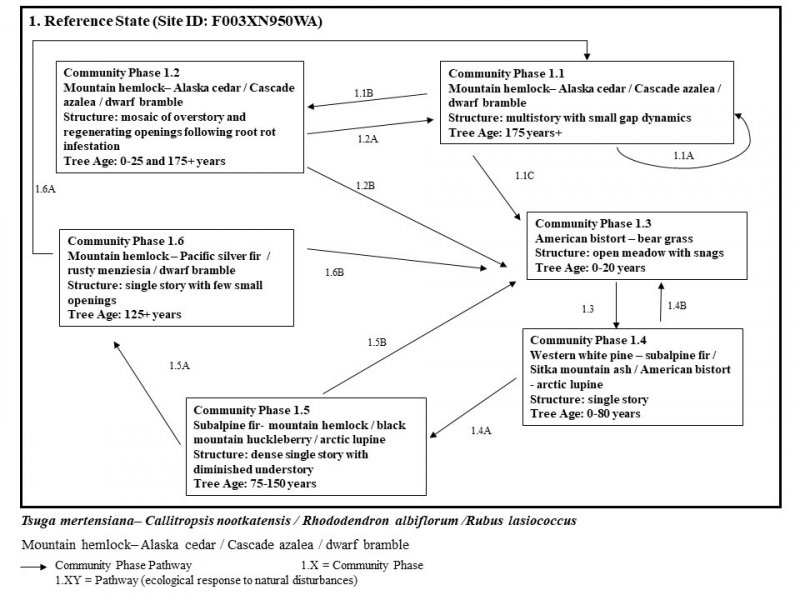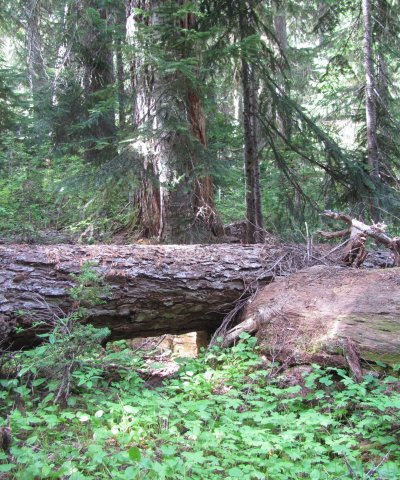
Natural Resources
Conservation Service
Ecological site F003XN950WA
Southern Washington Cascades Moist High Cryic Coniferous Forest
Last updated: 2/03/2025
Accessed: 12/20/2025
General information
Provisional. A provisional ecological site description has undergone quality control and quality assurance review. It contains a working state and transition model and enough information to identify the ecological site.
MLRA notes
Major Land Resource Area (MLRA): 003X–Olympic and Cascade Mountains
Steep mountains and narrow to broad, gently sloping valleys characterize this MLRA. A triple junction of two oceanic plates and one continental plate is directly offshore from Puget Sound. Subduction of the oceanic plates under the westerly and northwesterly moving continental plate contributes to volcanic activity in the Cascade Mountains. Movement among these plates has resulted in major earthquakes and the formation of large stratovolcanoes. The Cascade Mountains consist primarily of volcanic crystalline rock and some associated metasedimentary rock. The mean annual precipitation is dominantly 60 to 100 inches, but it is 30 to 60 inches on the east side of the Cascade Mountains.
The soil orders in this MLRA are dominantly Andisols, Spodosols, and Inceptisols and minor areas of Entisols and Histosols. The soils are dominantly in the frigid or cryic temperature regime and the udic moisture regime. The soils generally are shallow to very deep, well drained, ashy to medial, and loamy or sandy. They are on mountain slopes and ridges.
Ecological site concept
This ecological site is in cold, moist areas of Mount Rainier National Park at an elevation of 3,200 to 7,900 feet, depending on aspect. Elevation and climate are key components in the succession of the forest. The cold winters, deep snowpack, short growing season, and mild summers impact the rates of growth and maturity. Fog and a heavy cloud cover may provide moisture in summer for forests along the timberline (Crawford, 2009).
The soils that support this ecological site are in the cryic soil temperature regime and the aquic soil moisture regime. They are on debris aprons of mountain slopes, moraines, cirque floors, lahars, and swales of glacial-valley walls. The seasonal high water table is at a depth of 10 to 20 inches during part of the growing season. Soil moisture is not a limiting factor to forest growth because of the abundance of precipitation and the inherent water-holding properties of soils influenced by volcanic ash. A thin organic horizon consisting of decomposing twigs, needles, and litter is on the soil surface. This horizon helps to protect the soil from wind and water erosion.
The most common natural disturbance is windthrow due to the seasonal high water table. The shallow rooting zone in saturated areas causes roots to grow laterally and results in frequent tip-ups. Other disturbances include forest pathogens, such as root rot, and high-intensity, low-frequency wildfires that are stand replacing.
Mountain hemlock (Tsuga mertensiana) and Alaska cedar (Callitropsis nootkatensis) are the most common overstory species. Pacific silver fir (Abies amabilis), noble fir (Abies procera), subalpine fir (Abies lasiocarpa), Engelmann spruce (Picea engelmannii), and Sitka alder (Alnus viridis ssp. sinuata) may be minor components of the overstory. Cascade azalea (Rhododendron albiflorum), devilsclub (Oplopanax horridus), vine maple (Acer circinatum), salmonberry (Rubus spectabilis), and thimbleberry (Rubus parviflorus) make up the dense subcanopy.
Associated sites
| F003XN951WA |
Southern Washington Cascades High Cryic Coniferous Forest Ecological site F003XN950WA, Southern Washington Cascades Moist High Cryic Coniferous Forest, is located within the same elevation zone to site F003XN951WA, Southern Washington Cascades High Cryic Coniferous Forest. The dominant differentiating features are the depth to the water table and soil drainage class. The soils associated with site F003XN950WA have a higher water table depth during part of the growing season and are somewhat poorly drained. The vegetation on this site, such as Alaska cedar, Cascade azalea, and Sitka mountain ash, is suited to wetter environments. The soils associated with site F003XN951WA are moderately well drained or well drained. The vegetation on this site, such as subalpine fir and mountain heather, is suited to drier conditions. It is hypothesized that under long periods of drier conditions, F003XN950WA will progress toward an old-growth stand that resembles that of site F003XN951WA. |
|---|---|
| F003XN949WA |
Southern Washington Cascades High Cryic Riparian Forest Ecological Site F003XN949WA, Southern Washington Cascades High Cryic Riparian Forest is located within the same elevation as site F003XN950WA, Southern Washington Cascades Moist High Cryic Coniferous Forest. The sites are differentiated by disturbance regime and soil drainage. Ecological Site F003XN949WA is subject to flooding and vegetation is often less mature than site F003XN950WA. Vegetation within the riparian corridor is dominated by Alaska cedar, Sitka alder, and willows. |
Similar sites
| F003XN951WA |
Southern Washington Cascades High Cryic Coniferous Forest Ecological site F003XN950WA, Southern Washington Cascades Moist High Cryic Coniferous Forest, is located within the same elevation zone to site F003XN951WA, Southern Washington Cascades High Cryic Coniferous Forest. The dominant differentiating features are the depth to the water table and soil drainage class. The soils associated with site F003XN950WA have a higher water table depth during part of the growing season and are somewhat poorly drained. The vegetation on this site, such as Alaska cedar, Cascade azalea, and Sitka mountain ash, is suited to wetter environments. The soils associated with site F003XN951WA are moderately well drained or well drained. The vegetation on this site, such as subalpine fir and mountain heather, is suited to drier conditions. It is hypothesized that under long periods of drier conditions, F003XN950WA will progress toward an old-growth stand that resembles that of site F003XN951WA. |
|---|
Table 1. Dominant plant species
| Tree |
(1) Tsuga mertensiana |
|---|---|
| Shrub |
(1) Rhododendron albiflorum |
| Herbaceous |
Not specified |
Click on box and path labels to scroll to the respective text.


